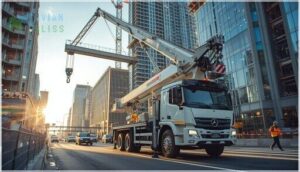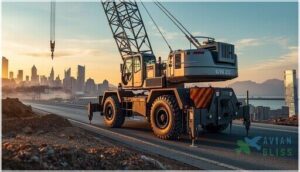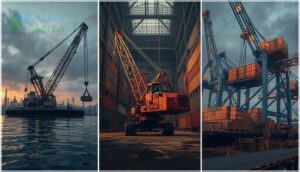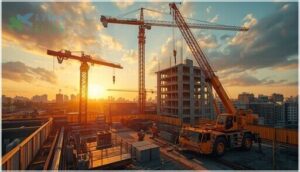This site is supported by our readers. We may earn a commission, at no cost to you, if you purchase through links.

The challenge? There’s no one-size-fits-all solution. Mobile cranes bring flexibility to the job site, fixed cranes deliver raw lifting power where you need it most, and specialty models tackle environments that would stop conventional equipment cold.
Understanding which crane fits your project means knowing what separates a crawler from a tower crane, or when an all-terrain model beats a truck-mounted rig.
Table Of Contents
- Key Takeaways
- What is a Crane and How Does It Work?
- Mobile Cranes: Types and Applications
- Fixed Cranes: Types and Characteristics
- Specialty Cranes for Unique Applications
- Choosing The Right Crane for Your Project
- Frequently Asked Questions (FAQs)
- What are the different types of construction cranes?
- What are the different types of migraine?
- What are the different types of mobile cranes?
- What are the different types of tower cranes?
- What are the four types of cranes?
- What are the different names of cranes?
- What are the three basic types of overhead cranes?
- What is the most common type of crane?
- What crane is best for my project?
- How much does crane rental cost?
- Conclusion
Key Takeaways
- Choosing the right crane depends on your project’s load, site conditions, duration, and strict safety regulations—there’s no one-size-fits-all solution.
- Cranes fall into four main categories: mobile, fixed, specialty, and overhead, each designed for specific lifting tasks and environments.
- Modern cranes pack advanced safety features like load monitoring, anti-collision sensors, and predictive maintenance, slashing accident rates and downtime.
- Mobile cranes dominate job sites for their flexibility, but fixed giants like tower and overhead cranes rule when you need serious lifting power and precision over time.
What is a Crane and How Does It Work?
Cranes are powerful lifting machines that combine basic physics principles with modern engineering to move loads that would be impossible to shift by hand. Understanding how they work starts with knowing their core components—from booms and pulleys to counterweights and hydraulic systems—and how these parts work together to generate massive lifting force.
Let’s break down the mechanics, explore where you’ll see cranes in action, and look at the safety features that keep operators and job sites secure.
Crane Components and Mechanisms
At the heart of every crane, you’ll find a surprisingly elegant system of interdependent parts working in concert. Here’s what makes these machines tick:
- The boom functions as the primary lifting arm—either a fixed lattice framework or a hydraulic telescoping arm that extends your reach
- Hoist systems use wire ropes and sheaves (pulleys) to multiply force and handle vertical lifting
- Counterweight balance prevents tip-overs by offsetting the load’s mass with adjustable weights
- Control systems coordinate boom mechanics, trolley movement, and rotation radius through the operator’s cab
- Safety mechanisms include outriggers for stability, load charts, braking systems, and anti-collision sensors
For enhanced stability, tower cranes are secured.
Common Uses in Industry
Understanding how cranes work is one thing—but where do you actually use them? Let’s break it down by sector:
| Industry Sector | Primary Crane Applications |
|---|---|
| Construction | Tower cranes for high-rise buildings; mobile cranes for bridge work and structural steel placement |
| Manufacturing | Overhead bridge cranes moving raw materials; workstation cranes supporting assembly lines |
| Ports & Shipping | Ship-to-shore gantry cranes handling containers; floating cranes for offshore cargo transfer |
| Energy & Oil | Offshore cranes on drilling platforms; crawler cranes installing wind turbines and solar arrays |
| Civil Projects | Mobile cranes positioning pipes for water systems; fixed cranes placing concrete in dam construction |
Construction applications dominate the crane market, with infrastructure projects accounting for the largest slice—over USD 51 billion globally in 2024. You’ll spot tower cranes defining city skylines during high-rise builds, while rough-terrain cranes tackle bridge construction in remote locations.
Manufacturing roles rely heavily on overhead systems. Gantry cranes, jib cranes, and automated stackers keep production flowing in automotive plants, steel mills, and warehouses—even in extreme temperatures. In North America alone, manufacturing grabbed 28.5% of crane market revenue last year.
Ports utilization centers on efficiency. Commercial port facilities deployed 539 ship-to-shore gantry cranes across the top 25 container ports in 2023, with AI integration slashing cargo dwell times and vessel turnaround.
The energy sector leans on specialized offshore cranes—lifting capacities between 500 and 2,000 metric tons handle modular construction on deepwater rigs and wind farms. The need for these cranes is expected to drive offshore crane market growth at a CAGR of 4.0% through 2035. Oil and gas operations command nearly half the offshore crane market.
Civil projects? Think utility infrastructure. You’ll find mobile cranes installing transmission towers, positioning pumps for sewage systems, and placing reinforcement in dam construction. Each crane type fulfills a specific industrial application, matched to load capacity, reach requirements, and site conditions.
Key Safety Features
All that power and precision needs bulletproof crane safety protocols to protect your crew. Modern systems layer multiple defenses—think load monitoring accurate to ±1–2%, collision avoidance using laser sensors, and operator assistance with AI-powered cameras detecting human presence near loads.
Emergency stops now cut secondary accidents by 71%, while predictive maintenance catches 89% of mechanical failures before they happen. Together, these crane operation and safety measures slash accident rates by 84% compared to standalone devices.
Mobile Cranes: Types and Applications
Mobile cranes are the workhorses you’ll see rolling from site to site, ready to tackle jobs where flexibility matters most. Unlike their fixed cousins, these machines can pack up and move under their own power, making them perfect for projects that demand quick setup and teardown.
Let’s break down the five main types and what makes each one shine in different conditions.
Truck-Mounted Cranes
Truck-mounted cranes are the Swiss Army knives of mobile cranes. You’ll find them shuttling steel beams and precast concrete across construction sites with impressive efficiency.
These adaptable types of mobile cranes combine lifting power with road-legal mobility, handling capacities from several tons to hundreds.
Modern truck-mounted cranes feature sophisticated safety enhancements like “Safety Eyes” for load handling, and their setup efficiency beats tower cranes hands down, cutting both project costs and time in urban applications.
All-Terrain Cranes
All-terrain cranes excel where you need both off-road capabilities and highway speed. These mobile crane types generally handle capacities under 200 tons, making them perfect for urban applications and remote sites alike.
Safety innovations and fuel efficiency drive their market growth—projected to hit USD 24.11 billion by 2030. Their versatility bridges the gap between truck-mounted cranes and specialized rough terrain cranes.
Rough-Terrain Cranes
Rough terrain cranes dominate offroad operations with their rugged wheels designed for uneven terrain. You’ll find these mobile crane types thriving on construction sites where accessibility challenges other equipment.
The 75 to 100-ton capacity range leads the market—projected to reach USD 24.32 billion by 2035—thanks to their versatility across mining, energy, and urban projects. Sustainable models are gaining traction as eco-friendly initiatives reshape the industry.
Crawler Cranes
Crawler cranes excel where offroad operations demand terrain stability that wheeled machines can’t match. Their track-mounted design delivers greater load capacity—handling projects that other mobile types struggle with.
Here’s why they’re infrastructure workhorses:
- Market growth reaching USD 4.08 billion by 2034
- AI integration cutting unscheduled downtime by 30%
- Heavy lifting for bridges, ports, and wind farms
- Rough terrain mobility without stability compromise
Carry Deck Cranes
Carry deck cranes bring lifting power inside tight spaces where mobility matters most. Their compact four-wheel design delivers impressive deck capacity—usually 10 tons or less—while offering maneuverability benefits that larger mobile cranes can’t match.
You’ll find them excelling in indoor applications like warehouses and manufacturing floors, though operator training and maintenance needs remain critical for safe heavy loads handling in confined quarters.
Fixed Cranes: Types and Characteristics
Fixed cranes stay put—they’re anchored to one spot and built for projects that need serious lifting power over extended periods. You’ll see them towering over construction sites, inside factories, and anywhere heavy loads need to move with precision and consistency.
Let’s walk through the main types you should know about.
Tower Cranes
When you’re building a skyscraper, you’ll spot tower cranes dominating the skyline—those tall, fixed giants that make high-rise lifting seem easy. Here’s what makes them essential for urban construction:
- They lift 6 to 20 tons (some hit 150 tons)
- Their 360-degree rotating jib covers massive areas
- About 100,000 operate worldwide
- The assembly process requires careful planning
- Strict safety protocols and future innovations keep improving efficiency
Overhead Bridge Cranes
Inside factories and warehouses, overhead bridge cranes move along parallel runways mounted to your building’s structure, delivering lifting capacities from 5 to over 32 tons across spans of 14 to 55 meters. You’ll find duty classifications like A5 for heavy-duty cycles, plus sophisticated features including regenerative braking and wireless control pendants.
The market’s climbing toward USD 8.2 billion by 2030—proof these workhorses aren’t disappearing anytime soon.
Gantry and Semi-Gantry Cranes
When you need lifting power but can’t install a fixed bridge, gantry cranes step in with their freestanding A-frame design. Single girder models handle 3.2 to 20 tons across spans of 8 to 35 meters, while semi-gantry configurations—riding on one elevated rail and one ground rail—stretch to 32 tons.
You’ll see work duties from A3 to A6, with trolley speeds hitting 40 meters per minute for efficient material handling in shipyards and outdoor manufacturing sites.
Level Luffing Cranes
Level luffing cranes keep your load at a constant height while the jib adjusts radius—perfect for congested site use like ports and tight urban zones.
With a $12.5 billion market in 2024 and infrastructure investments pushing growth to $21 billion by 2032, you’ll find automation features boosting precision on 45.3% of construction projects, especially where standard tower cranes can’t maneuver.
Hammerhead Cranes
Hammerhead cranes stand out with their iconic upside-down-L design—a fixed tower with a horizontal boom that rotates 360 degrees. You’ll recognize these heavy-lifters on large infrastructure projects, handling 20 to 88 tons with rock-solid stability.
In the USA, 22 hammerhead cranes tackle infrastructure (36%), general lifting (33%), and energy projects (17%), offering operational advantages when you need serious reach without sacrificing load control.
Luffing Jib Cranes
Luffing jib cranes give you something hammerheads can’t: a jib angle that adjusts on the fly. When you’re working in tight urban applications where neighboring buildings crowd your workspace, that variable reach keeps load stability locked in without swinging into obstacles.
Tower cranes with luffing jibs incorporate safety mechanisms like anti-collision sensors—a feature pointing toward future trends in crane types that prioritize precision over raw power.
Self-Erecting Cranes
Self-erecting tower cranes shine when you need a crane that sets itself up without a mobile crane assist. The erection process is quick—often under two hours—and transportability via standard truck keeps site requirements minimal.
This makes them ideal for smaller fixed cranes applications where space and cost analysis matter. You’ll find these mobile cranes alternatives on low-rise residential projects and tight urban renovations where traditional types of cranes won’t fit.
Specialty Cranes for Unique Applications
Not every job fits neatly into the mobile or fixed crane categories. Some projects throw curveballs—like lifting loads on water, working in tight indoor spaces, or hauling cargo on and off ships.
That’s where specialty cranes come in, each designed to tackle specific challenges that standard equipment just can’t handle.
Floating and Offshore Cranes
When you’re working in marine environments where land-based equipment can’t reach, floating cranes and offshore construction cranes become your heavy-lifting heroes. These specialized machines excel in deepwater operations and subsea lifting across harbor environments and open water. The global market’s climbing to USD 3.3 billion by 2035—driven by offshore energy projects and infrastructure demands.
Here’s what makes them indispensable for marine construction applications:
- Massive payload capacity mounted on barges or pontoons for stability
- Sophisticated digital controls with automated safety features ensuring offshore crane safety
- Remote monitoring systems optimizing efficiency in challenging conditions
Jib Cranes
For workspaces where you can’t justify a full overhead system, jib cranes deliver smart lifting solutions. These rotating arm configurations excel in fixed cranes applications—think assembly lines, loading docks, and machine shops.
The global jib crane market’s hitting USD 2.64 billion by 2034, fueled by automation features and remote-control safety innovations transforming port jib cranes and industrial applications with impressive efficiency gains.
Stacker and Bulk-Handling Cranes
When you’re moving massive volumes of raw materials—coal, grain, minerals—bulk-handling cranes are your workhorses at ports and storage facilities.
Stacker cranes transform automated storage and retrieval systems in warehouses, with the market hitting USD 1.59 billion by 2029.
Rail-guided systems now leverage AI optimization and digital twins for inventory management, slashing downtime while automation integration transforms efficient cargo handling across material handling in ports.
Aerial (Helicopter) Cranes
When ground access won’t cut it—think remote mountainsides or disaster zones—aerial cranes deliver heavy lifting from above.
The global air crane helicopter market is climbing from USD 6.62 billion in 2025 to USD 12.19 billion by 2032, driven by civil applications in infrastructure and military use.
High payload capacity exceeding 10,000 pounds and emerging autonomous capabilities are pushing innovation, with regional growth strongest across Asia-Pacific and North America.
Container and Harbor Cranes
Harbor cranes are the unsung heavyweights of global trade, moving containers at ports where efficiency means everything. The harbor crane market is expected to hit USD 13.5 billion by 2033, powered by port automation and technology advancements like AI-powered optimization.
Mobile harbor cranes dominate thanks to flexibility in marine environments, while gantry cranes and floating cranes tackle specialized marine construction across Asia-Pacific’s booming infrastructure.
Choosing The Right Crane for Your Project
Picking the right crane isn’t about grabbing the biggest machine you can find—it’s about matching the equipment to your project’s specific demands. You’ll need to weigh several factors, from how much weight you’re hoisting to where you’re working and how long you’ll need the crane on site.
Let’s break down the key considerations that’ll help you make a smart, safe choice.
Load Capacity and Reach
Matching your crane’s capacity to the job isn’t guesswork—it’s about understanding how boom length, load radius, and counterweight influence what you can safely lift. Here’s what shapes your lifting limits:
- Mobile cranes handle 10 to 60 tonnes, while specialized crawler units exceed 300 tonnes
- Capacity drops exponentially as boom length increases and load radius extends
- Tower cranes lift 2 to 20 tonnes, with reach topping out around 70 meters
- Counterweights—sometimes 20 tonnes themselves—boost lifting power but demand careful balancing
- Safety guidelines and load charts aren’t suggestions; they’re your roadmap to preventing catastrophic failures
Site Conditions and Accessibility
Once you’ve nailed capacity, site conditions and accessibility become the make-or-break factors. Soil stability dictates foundation needs—soft ground demands mats or reinforced pads, while urban areas throw in access planning headaches like narrow roads and height restrictions.
Weather impacts aren’t minor either; high winds halt operations fast. Don’t overlook space obstructions near power lines or buildings—proper site preparation and ground stability assessments prevent 75% of overturn incidents.
Project Duration and Mobility Needs
After reviewing site conditions, project duration and mobility needs shape your crane selection dramatically. Short gigs under 12 weeks favor mobile cranes—setup takes under two hours versus multi-day tower crane assembly. You’ll cut mobilization costs by 42% on multi-site jobs and slash downtime by 15%.
Fixed vs mobile? Long-term builds over three months justify tower cranes’ higher utilization rates despite initial setup investment.
Safety and Regulatory Compliance
Beyond mobility logistics, construction safety regulations determine which crane you can legally deploy. OSHA mandates operator certification and strict inspection protocols—pre-shift, monthly, and annual checks signed by qualified inspectors. You’re looking at load testing requirements for new or re-rated equipment, plus documented compliance records retained minimum one year. Skip these? Expect hefty fines and worksite shutdowns.
Key compliance checkpoints:
- Operator holds current NCCCO and OSHA certifications (renewed every five years)
- Load testing completed at 125% rated capacity before deployment
- Inspection records covering wire ropes, brakes, and electrical components
- Site hazard management addressing power lines and collision risks
Crane site hazard management isn’t optional—from 2011 to 2017, 154 fatalities resulted from crane-related strikes. Regulatory violations stack up fast: OSHA documented 838 safety breaches in 249 overhead crane incidents. Power line electrocution alone caused 32% of deaths between 1992 and 2006.
Modern anti-collision systems using radar and lasers help, but accident statistics show human error remains the biggest threat. That’s why certification requirements now extend beyond operators to lift directors, riggers, and signal persons. You’ll need state licenses in regions like New York and New Jersey on top of federal credentials.
Bottom line? Factor regulatory compliance into your crane selection from day one. The right equipment matched with proper safety protocols keeps your project moving and your crew going home safe.
Frequently Asked Questions (FAQs)
What are the different types of construction cranes?
Construction cranes fall into three main categories: mobile cranes (truck-mounted, all-terrain, rough-terrain, crawler), fixed crane types like tower cranes and overhead systems, plus specialty models for unique lifting capacity requirements and site accessibility challenges.
What are the different types of migraine?
Migraine types include those with aura (affecting 30-34% of sufferers), without aura (the most common), chronic migraine (impacting 1-2% globally), plus rare hemiplegic and vestibular variants—each presenting distinct symptoms.
What are the different types of mobile cranes?
Mobile cranes come in five main varieties: truck-mounted, all-terrain, rough-terrain, crawler, and carry deck models.
Each type offers distinct mobile crane versatility, balancing lifting capacity, terrain suitability, and hydraulic systems for specific applications.
What are the different types of tower cranes?
Tower cranes come in five main configurations, each designed for specific construction needs. Hammerhead models offer maximum reach for skyscrapers, while luffing jib types excel in tight urban construction sites. Self-erecting tower cranes deploy fast, flat tops simplify crane assembly, and mobile versions improve site accessibility.
What are the four types of cranes?
The industry recognizes four primary crane classifications: mobile cranes for adaptable transport, fixed cranes for stationary lifting, specialty cranes for unique applications, and overhead cranes designed for industrial facilities.
What are the different names of cranes?
Crane nomenclature varies by design, capacity, and regional names. You’ll encounter truck-mounted, all-terrain, rough-terrain, crawler cranes, tower cranes, floating cranes, and overhead models—each reflecting industry slang, model variations, and crane evolution across construction sectors.
What are the three basic types of overhead cranes?
You’ll find three main overhead crane types in factory environments: single girder models for lighter lifting equipment, double girder versions handling heavier industrial applications, and winch trolley cranes perfect for tight spaces.
What is the most common type of crane?
You’ll spot mobile cranes on nearly every jobsite you pass—they command 6% market dominance worldwide.
Their rental popularity and application versatility make them construction sites’ workhorses, especially as urbanization impact drives future growth.
What crane is best for my project?
Your construction project demands a mobile crane if you’re moving between sites, a tower crane for vertical reach, or a rough terrain crane for off-road conditions—match load requirements, terrain needs, project timeline, crane cost, and safety compliance.
How much does crane rental cost?
Rental rates vary widely—daily costs run $200 to $5,000 depending on crane type, capacity, and project duration.
Regional rate variations, operator fees, insurance costs, permits, and transportation add up, so clarify hidden rental fees upfront.
Conclusion
Think of cranes as the chess pieces of construction—each type has a move that changes the game. Whether you’re wrangling steel downtown or lifting cargo at the harbor, knowing the types of cranes means you’re playing with strategy, not luck.
The right choice isn’t just about muscle; it’s about matching machine to mission. So next time you size up a job site, remember: mastery comes from understanding the lineup before you make your move.
- https://straitsresearch.com/report/mobile-crane-market
- https://www.grandviewresearch.com/industry-analysis/mobile-cranes-market
- https://www.cranebriefing.com/news/act-tower-crane-50-2025-data-reveals-industrys-pivot-toward-stability/8082855.article
- https://www.craneequipmentguide.com/article/63255-tower-crane-numbers-across-north-america-holding-their-own
- https://blog.ansi.org/ansi/tower-cranes-throughout-world/











